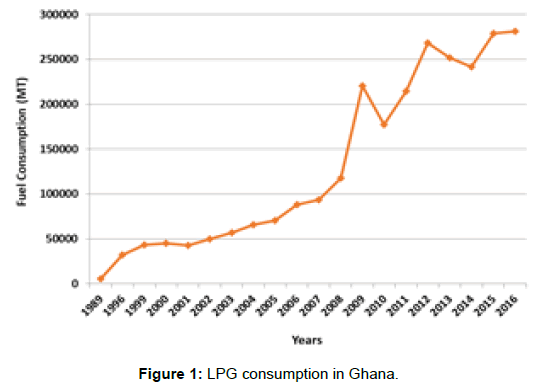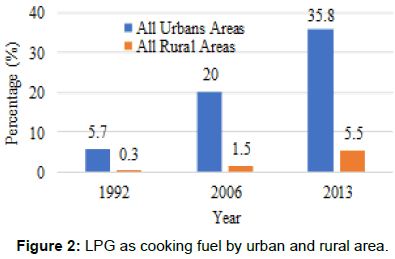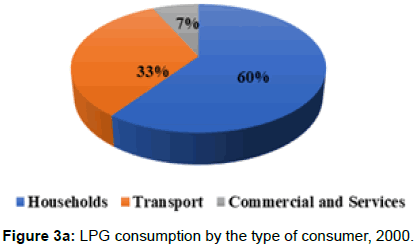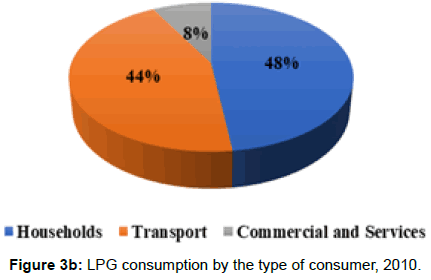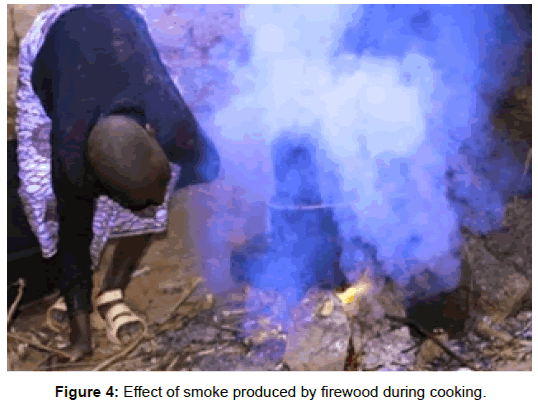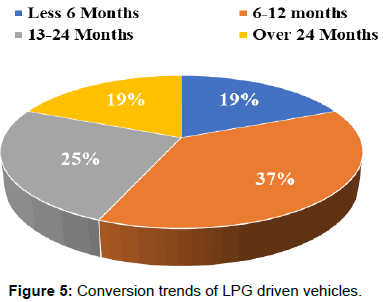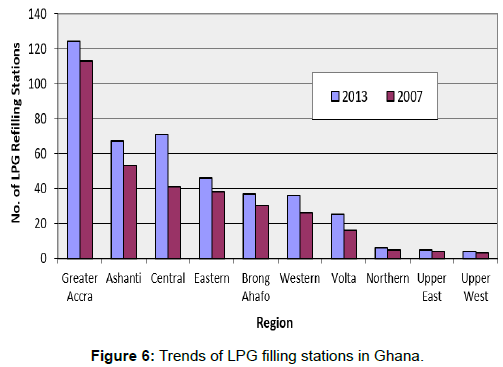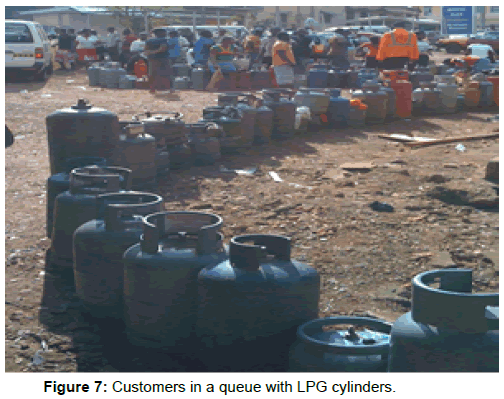The Ghana Liquefied Petroleum Gas Promotion Programme: Opportunities, Challenges and the Way Forward
Received: 29-Mar-2018 / Accepted Date: 09-Apr-2018 / Published Date: 12-Apr-2018 DOI: 10.4172/2576-1463.1000197
Abstract
The pursuit for energy has evolved over the years and this has resulted in a sharp increase in demand with a corresponding increase in needs. With an ever-increasing awareness for the use of environmentally friendly fuels, the Government of Ghana initiated the Ghana LPG Promotion Programme in 1990 with the primary aim of eliminating the flaring of LPG at Tema Oil Refinery and encouraging the citizenry to switch to LPG usage due to its advantages over wood fuel. The Ghana LPG Promotion Programme has received good responses from citizens since its inception; however, there are some challenges that have to be addressed to ensure the long-term aim of the programme is accomplished and sustained. This research seeks to identify the opportunities and the challenges of LPG promotion in Ghana using secondary data. Some of the opportunities identified included job creation; reduction in the health and environmental problems associated with wood fuel and provided alternative fuel for gasoline powered vehicles. However, some of the challenges identified included lack of safety education on LPG usage, increasing cost LPG and its accessories, sporadic shortage of LPG, lack of prototype LPG stove, lack of accessibility and poor LPG transporting network. It is recommended that Government should increase LPG access to rural consumers by encouraging private investors to build refilling plants at safe locations that can easily be accessed during market days, ensure more education on best safety practices and innovations on LPG usage to reduce LPG associated hazards and also, government should institute a clear-cut policies and regulatory changes that will encourage the usage of LPG in Ghana.
Keywords: Liquefied Petroleum Gas (LPG); Safety; Wood fuel
Introduction
Energy is one of the very basic needs of mankind to sustain life on earth; this energy is provided in different forms in man’s immediate environment. Over the years, the issues of accessibility, affordability and pollution of the environment plays a major role on the type of energy to use. With the increase awareness of the problems associated with the burning of wood fuel, the Government of Ghana promoted the use of Liquefied Petroleum Gas (LPG). The Programme has received good responses from citizens [1] since its inception; however, there are some challenges that have to be addressed to ensure the long-term aim of the programme is accomplished and sustained. This research seeks to identify the opportunities and the challenges of LPG promotion in Ghana. It will also suggest the possible ways of dealing with the challenges.
The Ghana LPG Promotion Programme
The Ghana LPG promotion programme started in 1990 with short and long term aims of eliminating flaring of LPG at Tema Oil Refinery and ensuring that households that use wood fuel (charcoal and fire wood) for cooking adopt to the use of better and cleaner fuel like LPG [2,3]. The promotion targeted urban households, public institutions requiring mass catering facilities and the informal commercial sector including small-scale food sellers. Extensive promotional and educational campaigns were also carried out to educate the public on the environmental, health and safety regulations as well as the benefits of switching to LPG [3]. The promotion of the usage of LPG as a policy by the government of Ghana was to safeguard the fast depletion of the nation’s forests. Since the inception of this policy, there has been a consistent effort by Government to subsidise the commodity so as to make it affordable for domestic use [4] until 2013 when the Government removed the subsidy. In spite of this intervention by the Government, the country’s energy needs relied mainly on wood fuel for cooking. Wood fuel accounts for 73.9% of energy needs according to the 2010 population and housing census [5]. The figure clearly confirms the fact that wood fuel remains the country’s biggest source of energy supply, employing thousands of people in the country. Among the Government’s intervention initiatives, has been the setting up of a gas cylinder manufacturing company in the country; Ghana Cylinder Manufacturing Company (GCMC), to manufacture gas cylinders locally and make them available to the public at affordable prices. This intervention increased the quantity of cylinders in circulation from 80,000 in 1989 to 600,000 in 1997. The overall LPG consumption also increased from 5,267 tonnes (metric tons) in 1989 to 32,000 tonnes in 1996 [2].
Another measure was to encourage private sector participation by way of investment in the storage and distribution network of petroleum products; LPG refilling stations; throughout the country. This programme has increasingly led to the springing up of about 647 LPG refilling stations nationwide. From the statistics numerated above, it can be stated that the programme which is to encourage people to change from the use of wood fuel to LPG has yielded positive results. The Ghana LPG Promotion Programme has received good responses from citizens especially urban dwellers as there has been increasing consumption level year after year except 2010, 2013 and 2014 where shortages of LPG occurred in some parts of Ghana (Figure 1) [6].
Despite the increasing consumption, the penetration of LPG in rural communities is still a challenge. There is a big gap between LPG patronages in urbans areas compared to rural areas (Figure 2) [7-9]. To encourage the use of LPG in rural areas, the government of Ghana through the Ministry of Energy and Petroleum in 2013, launched a Rural LPG programme. The programme was to reverse the detrimental effect of the continuous burning of more than 13 million tonnes of firewood annually, reduce respiratory diseases acquired from the firewood burning, and save mothers and children from drudgery and the dangers of fetching firewood [10].
Under the Rural LPG Programme, Government is distributing 50,000 free cylinders, cook stoves and all related accessories to beneficiaries in low access and low-income areas in districts across the nation. This is done to enable rural dwellers switch easily from wood fuels to LPG without paying for the initial investment costs.
Materials and Methods
Secondary data were employed for this research. The secondary data per this research consisted of already existing data from Ministry of Energy, Ghana Statistical Service, Ghana National Petroleum Corporation and National Petroleum Authority. Information from journal papers, text books, unpublished materials and recognized websites were also used.
Opportunities of the Ghana Liquefied Petroleum Gas Promotion Programme
This section reveals the opportunities of Ghana LPG Programme since its inception. The following opportunities were revealed during the research.
Job creation
The Ghana LPG Promotion Programme has led to an increase in new job creations for some mechanics and welders who are employed at Ghana Cylinder Manufacturing Company (GCMC) to manufacture cylinders and provide maintenance services on all defected equipment. Some skilled and unskilled youths have been employed as sales agents and drivers providing needed “door-to-door’’ services to expectant customers. More refilling attendants have also been employed due to the increasing numbers of LPG refilling centres (currently about 647 refilling stations) across the country. The programme has also increased the job of metal scrap dealers who supply GCMC with more materials for easy construction of the cylinders. The metal scrap dealers also help in bringing all the old and defected cylinders in the system to GCMC for maintenance and reconstruction purposes and thus reducing the environmental risk posed by defected LPG cylinder. The programme has also provided jobs for mechanics who convert gasoline or diesel driver cars to LPG driven cars [11]. The consumption of LPG has also created jobs in the areas of LPG accessories retails such as rubber tubing, gas, gas lighters, gas stove stands, and the construction of many LPG filling stations around the nation.
Alternative fuel for commercial vehicles
A research conducted by Energy Commission (EC) of Ghana in 2011 revealed that about 37% of LPG supply to Ghanaian market is consumed by vehicles while the remaining 63% is consumed by households and others [12]. Another report by the EC of Ghana in 2015 revealed the increasing trend of LPG in the transport sector for commercial vehicles in the year 2000 and 2010 (Figures 3a and 3b) [13]. This indicates that commercial vehicle drivers have found LPG cheaper than other transport fuels. Research conducted by Biscoff et al. [11] in the Volta Region of Ghana revealed that taxi drivers convert gasoline driven vehicle to LPG driven vehicle for profit gain since the rate of consumption is relatively lower and cheaper as compared to gasoline.
This assertion by the drivers was confirmed by a research conducted by Kwaw [14] in Tarkwa when government subsidy on LPG was removed. Taxi drivers in Tarkwa revealed that, though there has been gradual increase in the price of LPG in Ghana since 2013, LPG driven cars are still economical compared to diesel and gasoline driven cars. This finding was confirmed by a similar work done by Worlanyo in 2017 [15] at Tema Community 1. The use of LPG as a fuel for both private and commercial vehicles reduce demand on gasoline, and diesel.
Reduction in wood fuel health-related problems
Another major opportunity of the LPG promotion programme is its ability to reduce health issues associated with the use of wood fuel. The use of LPG helps reduce substantial amount of emission of carcinogenic substances as well as other pollutants into the environment. It also reduces the pains that results from the carrying of tens of kilos of wood fuel over long distances by mostly children and women in the rural communities. Figure 4 shows pollution due to the use of fire wood during cooking [16].
Reduction in environmental-related problems
The use of LPG in place of other sources of energy such as fuel or coal is proving to be a great fuel choice as far as the environment is concerned. It is one of the cleanest of all hydrocarbons, as it produces little nitrogen oxide, sulphur dioxide or particulates when combusted. In terms of protecting the environment, it reduces deforestation, erosion and air pollution. The promotion programme has yielded positive results particularly in the urban areas thereby reducing the demand on wood fuel. Before the government’s LPG promotion programme, according to the Ghana Living Standards Survey (GLSS) of 1988, only 4.8% of the population in Accra (Greater Accra Metropolitan Area [GAMA]) used LPG, 0.8% of the population in other urban areas used LPG and nobody in the rural areas used LPG. As at the year 2000, according to a survey by GLSS, the percentage of LPG users in Accra has moved from 4.8% to 22.7%, 0.8% to 5.2% of the population in other urban areas and 0% to 0.6% of the population in the rural areas [2]. According to 2000 Population and Housing Census, 21.8% of the population in Greater Accra Region used LPG as cooking fuel whilst 4.8% of the population in Ashanti Region used LPG [3]. As at the 2010 Population and Housing Census, the use of LPG as cooking fuel in Greater Accra region has moved from 21.8% to 41.4% and 4.8% to 21.1% in the Ashanti [5]. A survey conducted again by GLSS in 2013 revealed an increase in LPG consumption as cooking fuel in Accra (GAMA) to 52.7%, 28% in other urbans areas and 5.5% in the rural areas [17].
Most domestic and commercial users of LPG for cooking have noticed and testified about the cost effectiveness of using LPG over the use of other fuel sources. It has also improved the safety of the environment by reducing pollution and keeping the kitchen neat and clean from smoke and ashes which are the by-products of using wood fuel [1]. This is a positive response because these consumers who would have depended on wood fuel are now using LPG, thus reducing the demand on wood fuel and its associated environmental effects.
Increase in Government’s revenue
The annual consumption of LPG has experienced a sharp increase from 5,267 tonnes in 1989 to 43,503 tonnes in 1999. Annual LPG consumption grew steadily from 45,000 tonnes in 2000 to 220,603 tonnes in 2009 but dropped to 177,192 tonnes in 2010 due to a long shutdown of the Tema Oil Refinery. The consumption of LPG has grown considerably averaging over 37% between 2010 and 2016. This increase in LPG consumption brings some economic benefits to the country. The consumption of LPG has resulted in an increase sales of LPG accessories such as rubber tubing, gas, gas lighters, gas stove stands, and the construction of many LPG filling stations around the nation. The amount of taxes paid by the owners and consumers of LPG help to increase the government’s annual revenue.
Results and Discussion
Challenges of LPG utilization in Ghana
This section reveals the challenges of the Ghana LPG Promotion Programme since its inception in 1990. The identified challenges include; lack of effective safety education on the usage of LPG, increase in LPG driven vehicle, frequent rise in the cost of LPG and its accessories, lack of accessibility of LPG and high level of risk in transporting LPG.
Lack of effective safety education on LPG usage
Safety education means improving knowledge, skill, attitude and morale of the workers. It is a process of systematic instructions and development of character or mental powers of the workers. It must prevent both unsafe conditions and unsafe acts [18]. An effective training programme can reduce the number of injuries and deaths, property damage, legal liability, illnesses, and compensation claims. Even though extensive promotional and educational campaigns were carried out to ensure that environmental, health and safety regulations were observed and the benefits of switching to LPG was communicated to the public [3], there has been series of accidents due to lack of effective system to ensure the continuity of educating new users on the proper ways for handling LPG. In 2014, two student nurses died at Nyaniba Healthcare Training School, a private Nursing school in Tema as a result of a gas cylinder explosion [19].
Between 2007 and 2015, about ninety-six (96) persons died while 486 sustained various degrees of injuries in only 19 reported cases involving LPG explosions [20]. Out of the 19 cases, 9 involved industrial settings (gas stations, fuel stations and a fuel dump), while 6 were gas tanker crashes, with the remaining four being domestic accidents. A research conducted by Broni-Bediako et al. [21] revealed lack of safety knowledge of LPG domestic users in Tarkwa, as majority of the users lack the basic safety procedures when connecting full cylinder to LPG appliance, how to detects leaks and the use of safety cap of their cylinder. Surprisingly, the research revealed that majority of the domestic users have no idea on how to detect leaks and good percentage uses matchstick to detect LPG leaks; which is very dangerous as far as LPG handling is concerned.
Frequent rise in the cost of LPG and its accessories
Another major challenge facing the utilization of LPG in Ghana is the frequent rise in the cost of LPG and its accessories. The onset of the LPG utilization programme has experienced price volatility from 1990 till now. In 2006, the price of LPG changed over four times. Within this period, the price increased over 36%, with the highest price of an 18 kg LPG at GH₵13.65 occurring in June, 2006. However, the price dipped by about 8 percent to GH₵12.53 as of September 2006. In 2014, the price of an 18 kg of LPG was abut GH₵ 51.66 which is more than twice the price of two and a half bags of charcoal [22]. Thus, there is high price volatility with respect to this product. Currently, the price of 18 kg of LPG is about GHC 90 which is 43% increment from 2014 to February 2018. This rapid increase in the price of LPG and the comparative lower prices of other fuels like firewood and charcoal has resulted in most prospecting consumers returning to use the later mentioned fuels especially the rural dwellers. Also, the cost of purchasing and maintaining LPG and its accessories which include gas cylinder, gas stoves, rubber tubing has decreased the interest of most potential users in the rural areas who may not have the means to purchase such items and even maintain and repair their appliances.
Increase in LPG driven vehicles
Promoting gas consumption for industrial use and other sectors such as transportation was not a priority for the government at the time of the LPG Promotion Programme [23]. Government policies concerning LPG were centred on domestic consumption of LPG to the neglect of the other sectors. Therefore, agencies responsible for formulating, coordinating, implementation and monitoring energy policies have focused solely on residential use of LPG. LPG as automotive fuel is not regulated by any policy in Ghana now. However, most of the LPG produced was being patronised by motor vehicle drivers resulting in competition with domestic users and other totally defeating the purpose for which government has made huge investments to establish a viable LPG market in Ghana. A research conducted by EC in 2011 revealed that about 37% of LPG supply to Ghanaian market is consumed by vehicles while the remaining 63% is consumed by households and others [12]. The shift from the use of conventional petrol and diesel to the use of LPG due to economic reason by taxis and other vehicles constituted a tax evasion. This is so because, government, has placed duties and levies such as Road Fund Levy, Excise Duty, Energy Fund Levy and Exploration Levy on the price of all fuels used in motor vehicles as a way of generating revenue for road maintenance and others [23]. As LPG was not intended to be used in vehicles in Ghana, these levies were not placed on the gas resulting in revenue loss since time of LPG promotion to 2013. The gradual removal of LPG subsides since 2013 has resulted in the reduction of converting diesel and petrol driven vehicles to LPG, thereby reducing the patronage of LPG by drivers. This shows in a research conducted by Kwaw in 2014 (Figure 5) [14].
Lack of accessibility of LPG
Inadequate refilling stations in rural areas have been the main cause of low patronage of LPG products by the rural dwellers. As of December 2003, there were 98 LPG refilling stations in Ghana, 64 of which were situated in the Greater Accra region and only one station each in the Upper East and Upper West regions [3]. This situation of lack of accessibility of LPG in the Upper East and West has not greatly changed as there are only 9 filling stations in the Upper East and West regions as at December 2013 (Figure 6).
Lack of LPG accessibility has reduced the ability of most prospecting customers to easily get access to the product since they must travel long distances to the supply point. This challenge has made many prospecting buyers to focus on wood fuel which is readily available and easily accessible.
Sporadic shortages of LPG
Nigeria has been the major supplier of LPG to Ghana for more than two decades now until the construction of Atuabo Gas Processing Plant to support the supplier from Nigeria. The increasing population of both nations with their attendant quest to utilise more energy has placed a lot of restrictions on the quantity of LPG to be supplied to Ghana within a given year. From 2013 to 2015, the quantity of gas needed by Ghana to produce enough electricity for her citizens reduced and this led to sporadic power outages and the need to implement a load shedding exercise in the country. This challenge adversely affected so many production firms who depend mainly on electricity to run their day-to-day activities to be at a stand-still.
In addition, there are inadequate LPG storage facilities within the country to store excess LPG and therefore results in shortage with demand in a certain period. In 2013 and 2014 the consumption rate of LPG reduced due to shortages that major cities in Ghana who are the major consumers of LPG. LPG shortages lead long queues at gas refilling stations for several days thereby reducing economic downtime of the citizenry (Figure 7) [24]. It affects businesses such as food vendors, welders, motorist and many others. LPG shortage also reduces productivity, creates anxiety and inconveniences as users may have to adopt traditional fuels which are not very effective and environmentally safe as compared to LPG [1].
High risk of transporting LPG
Currently the only source of transporting LPG to consumers is by road. Since LPG is transported only by road, the nature of the access roads to a particular community affects the interest of the investors in that area. Bad roads to rural areas have also made it an impossible task to transport LPG products to waiting and expectant customers. The cost of transporting the product has a negative effect on the total cost of purchasing it.
Conclusions
From the research, it could be concluded that:
i. New jobs have been created in the LPG industry and its related areas.
ii. There is a gradual switch from wood fuel to LPG mostly in the urban areas.
iii. LPG is gaining popularity as an alternative fuel for commercial vehicles due to its improved economic value. However, there is a gradual drop in the converting gasoline and diesel cars to LPG due to subsidy removal.
iv. Lack of publication on the best safety practice of using LPG has affected the promotion programme.
v. There is poor access of LPG to rural areas as compared to urban areas due to bad roads connecting the rural areas to the urban areas.
Recommendations
Based on the conclusions, the following recommendations were made:
i. Publication of best safety practices and innovations on LPG usage should be increased in the media.
ii. There should be extensive public awareness on the negative impact of traditional fuel on health and the environment to deter people from using charcoal and firewood.
iii. Government should increase LPG access to rural consumers by encouraging investors to build LPG refilling plants at safe location that can easily be accessed during market days.
Government should institute a clear-cut policies and regulatory changes that will encourage the usage of LPG in Ghana.
References
- Broni-Bediako E, Dankwa KO (2013) Assessment of liquefied petroleum gas (LPG) utilisation in Ghana, A study at Tarkwa. Int J Sci Technol Res 2: 6-10.
- Quaye-Foli EA (2002) Liquefied Petroleum Gas (LPG) Promotion: The Ghana Experience, Presentation at UNDP/World Bank-Energy and Poverty Workshop, Addis Ababa, Ethiopia. pp: 1-34.
- Anon (2004) Liquefied Petroleum Gas (LPG) Substitution for Wood Fuel in Ghana: Opportunities and Challenges.
- Kotoku EA (2013) Shortage of LPG in Ghana, Customer Service Affair, National Petroleum Authorithy.
- Anon (2012) SE4ALL-Ghana Sustainable Energy for all Action Plan. Energy Commission Report.
- Anon (2018b) Petroleum Minister Launches Rural LPG Programme in the Northern. Ministry of Petroleum Region Press Release 2015.
- Anon (1995) Ghana Living Standards Survey, Report on the Third Round (GLSS3). Ghana Statistical Service, Accra. pp: 204.
- Anon (2008) Ghana Living Standards Survey, Report on the Fifth Round (GLSS5). Ghana Statistical Service, Accra. pp: 146.
- Anon (2014b) Ghana Living Standards Survey, Report on the Sixth Round (GLSS6). Ghana Statistical Service, Accra. pp: 244.
- Biscoff R, Akple M, Turkson R, Klomegah W (2012) Scenario of the emerging shift from gasoline to LPG fuelled cars in Ghana: A Case Study in Ho Municipality, Volta Region. Energy Policy 44: 354-361.
- Edjekumhene I (2011) LPG in Ghana: From Crisis To 50% Access: A Public Policy. Analyst's Perspective. Presentation Delivered at TEC LPG Seminar Series 2011. pp: 44.
- Anon (2018b) Access to Clean Energy through Establishment of Market-based Solutions in Ghana.
- Kwaw AJ (2014) The Use of LPG as a Fuel for Commercial Vehicles in Ghana: A Case Study. Unpublished BSc Project Report, University of Mines and Technology, Tarkwa. pp: 38.
- Degboe WE (2017) Assessing the Safety Knowledge of LPG Powered in Vehicles Using Tema Community One as a Case Study. Unpublished Bsc. Project Work, University of Mines and Technology. pp: 38.
- Anon (2014a) Ghana Living Standards Survey, Report on the Sixth Round (GLSS6). Ghana Statistical Service, Accra. pp: 244.
- Bhattacharjee G, Neogi S, Das SK (2011) Safety knowledge of LPG auto drivers and LPG tank drivers. Open Journal of Safety Science and Technology 1: 101-107.
- Broni-Bediako E, Amorin R, Koomson-Awortwe S (2017) Safety Knowledge of Domestic Liquefied Petroleum Gas (LPG) Users in Ghana: A Case Study. J Pet Coal 59: 54-61.
- Inkoom DK, Biney BS (2010) The potential of liquefied petroleum gas (LPG) as a viable energy option for the industrial sector in Ghana. J Sust Dev Africa 12: 34-61.
- Ampofo K (2010) Ghana’s Worsening LPG Shortages: “What to Doâ€
Citation: Broni-Bediako E, Amorin R (2018) The Ghana Liquefied Petroleum Gas Promotion Programme: Opportunities, Challenges and the Way Forward. Innov Ener Res 7:197. DOI: 10.4172/2576-1463.1000197
Copyright: © 2018 Broni-Bediako E, et al. This is an open-access article distributed under the terms of the Creative Commons Attribution License, which permits unrestricted use, distribution, and reproduction in any medium, provided the original author and source are credited.
Share This Article
Recommended Journals
Open Access Journals
Article Tools
Article Usage
- Total views: 9699
- [From(publication date): 0-2018 - Nov 24, 2024]
- Breakdown by view type
- HTML page views: 8843
- PDF downloads: 856

